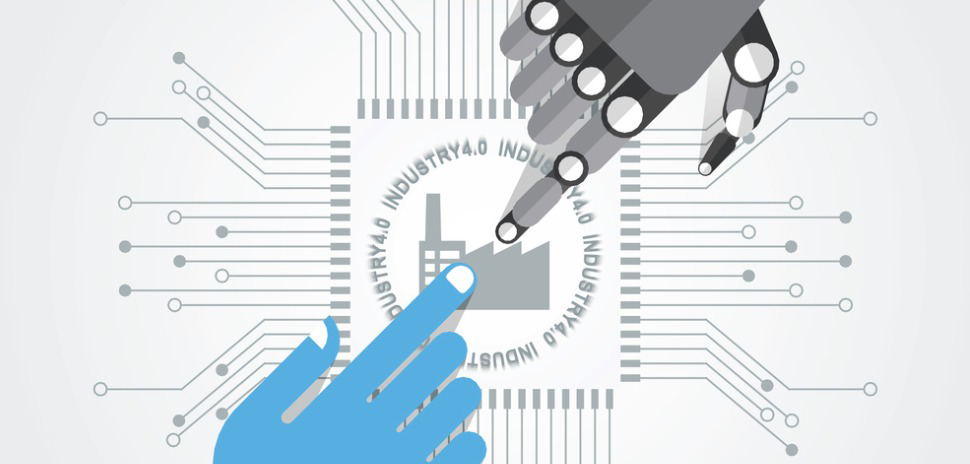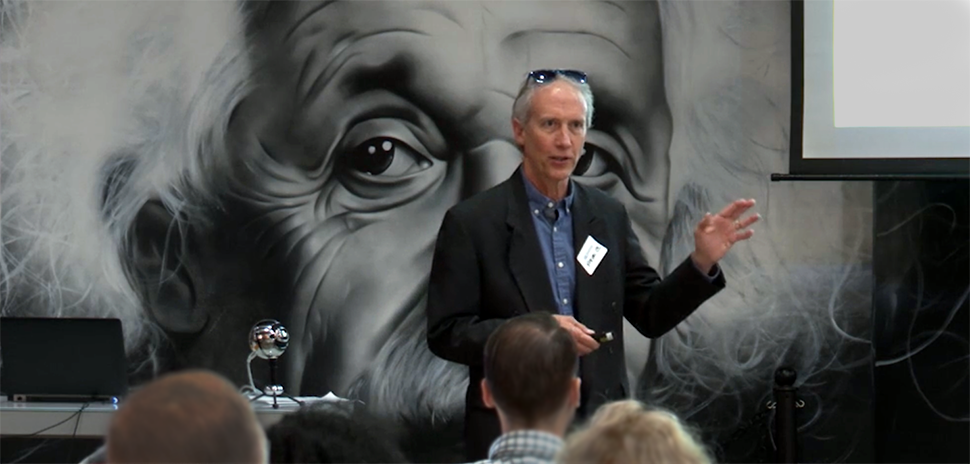The future will be increasingly digital — and yes, that means even some jobs will go by the wayside — but experts say companies should not view the virtual robots that are entering the workforce as foes.
“I think very often people hear automation and automatically think that’s an elimination of jobs,” said Kim Curley, people and organizational change practice lead for NTT Data Services. “That’s not always the case and it doesn’t necessarily have to be the case. I think the real winners are going to be the ones that figure out this is a great tool to make your people more capable and more productive.”
“I think the real winners are going to be the ones that figure out this is a great tool to make your people more capable and more productive.”
Kim Curley
Robotic Process Automation is the technology that uses software with artificial intelligence to handle manual, repetitive tasks such as manipulating data, server maintenance, or records management. Companies, especially in the financial services and insurance sectors, are relying on these virtual bots to perform the repeatable work freeing up humans to be more effective in other areas of their jobs.
“This competency is a new set of muscles and a new set of brains to manage those muscles to get automation done,” said Gregory North, principal adviser at the Institute for Robotic Process Automation and Artificial Intelligence, during a recent NTT Data Services Innovation Summit covering RPA in Addison.
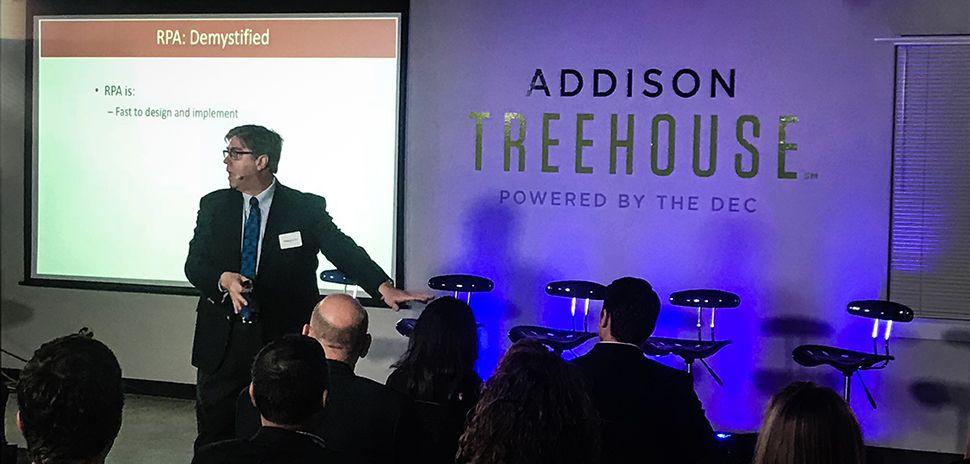
Gregory North, principal adviser at the Institute for Robotic Process Automation and Artificial Intelligence, talks about RPA during a recent NTT Data Services Innovation Summit at the Addison TreeHouse. [Photo courtesy of NTT Data Services]
For now, this digital labor force is made up of what Michael Goodman of NTT Data Services calls task bots.
“I think people generally overestimate the capabilities of bots today and underestimate the speed of the evolution. They are pretty good, but they are getting a lot better fast,” said Goodman, who is a senior director of data and analytics practice lead for the IT services provider.
Plano-based NTT Data Services held the private event for its clients to discuss the impending digital workforce and how companies can implement automation without the headaches.
“I think people generally overestimate the capabilities of bots today and underestimate the speed of the evolution.”
Michael Goodman
The summit included everything from North’s crash course on RPA to things to consider when adding bots to your workforce by Curley and Goodman. Jimit Arora, who leads Everest Group’s IT services research practice, gave a rundown on navigating the sprawling RPA vendor landscape, suggesting companies ask what the vision and capability of each tool is as well as the market impact they have.
Here are some takeaways from a panel gathering all the experts to talk about RPA and its impact in the business world.
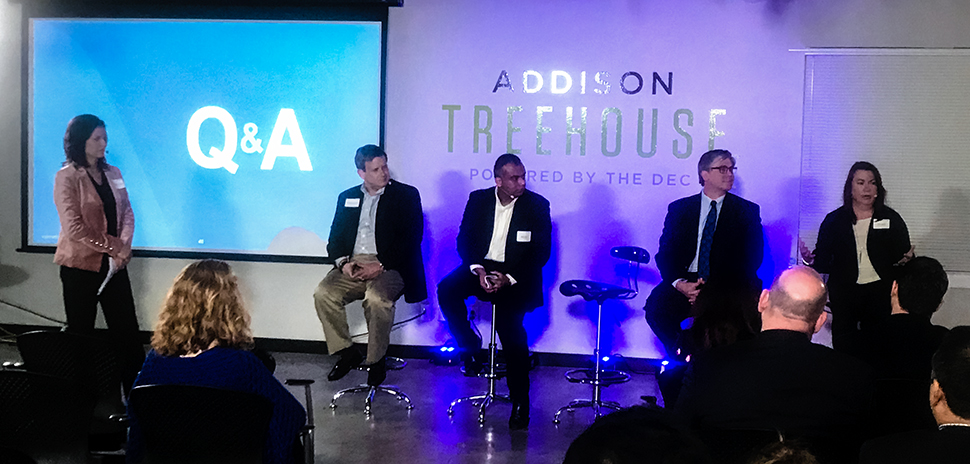
Panelists at the event included Michael Goodman, Jimit Arora, Gregory North, and Kim Curley. [Photo courtesy of NTT Data Services]
What do you think is the most likely pitfall, when companies are beginning to embark on [automation] at scale?
Curley: I’d say in the early stages where they are falling down is consistency of message and communication throughout the organization.
You want to make sure you have the consistency of message so that you aren’t creating uncertainty. When people have uncertainty, they tend to create their own stories and make up the end game, whether that’s your intended end game or not.
“You want to make sure you have the consistency of message so that you aren’t creating uncertainty.
Kim Curley
The challenge when you get to scale is whether or not you’ve been able to create the agility and the resilience inside your organization to be able to withstand the cycles of change that are coming with that scale.
How do you recommend organizations tackle the long-term plans with the short-term need to automate?
Arora: The reality is that it’s not going to be possible for 98 percent of enterprises to go down that true end-to-end digital bots, which is why you are going to need more automation that is happening. Which is why we are talking about, how do you prevent things from imploding?
Can you explain what bot mortality means and, conceptually, how do you kill a bot and how do you bring it back to life?
Goodman: Sometimes you want a bot for a specific period of time. Application software, we tend think about having a very long lifespan. Depending on the process, engineering the bots are more closely tied to the process, so you may have a bot that exists for a particular period of time.
The bot mortality that I worry about is the process change that comes in that causes the bot to stop working. That’s an age old challenge. You’ve got third parties that will sometimes give you enough lead time. Sometimes you can use a third part such as us, where we have strategic alliances with some of the vendors and may be able to get insight ahead of time in terms of the changes that are being made. That’s something you need to think about: when you change your application, you change your process, you need to change your people and you need to change your bots.
As you look out three to five years, which job do you think is going to be most impacted [by automation]?
North: I would say customer service. I would say it’s fast becoming an area where companies are realizing that consumers prefer to self-serve if they can. And, if they can’t, they’d rather have an immediate answer pop to them by some sort of digital presence.
I was in business process outsourcing for a couple of decades. Companies have very large call centers with many people in them doing a lot of work. I think that entity is going to almost completely go away.
Look across your organizations for anyone who has the job title that includes the word ‘analyst’ in it. It’s not a RPA role necessarily, but as we move into cognitive, the ability of automation to start doing data mining and do analytics on top of that, so many of the people whose job it is to pour over millions of records until they fall asleep, automation is tailor-made for that.
Curly: I work a lot in the financial services industry, so I’d say there’s still a tremendous amount of solitary activity that you like. In some ways it’s that bridge that we talked about of moving from one system into another because they don’t have a way to connect the two. I think some of those will start to continue to drop off. I think there’s a whole lot of low hanging fruit in that particular arena.
“Look across your organizations for anyone who has the job title that includes the word ‘analyst’ in it.”
Gregory North
Arora: I largely agree with the customer service angle. If you go back to one of the most innovative companies when it comes to customer service — Amazon. They say ‘hey, the best customer service is no service in which case you don’t really need it.’
Goodman: I look at it two ways. I think there’s going to be not only the reduction in the customer service and those areas, but I think as people start to think about bots from the what else can we do? What more we can do? Particularly in support of the customer experience. What other information can we capture? How can we collect more? How can we process more? How can we get a better insight into our customer?
They’re going to drive reductions in some areas, but they’re also going to drive increased understanding, increased insight in other areas.
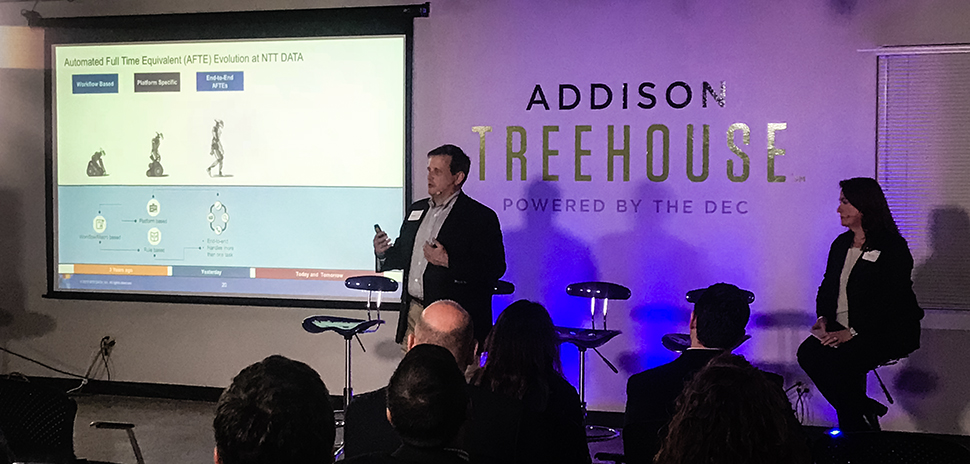
Michael Goodman (left) and Kim Curley of NTT Data Services talk about integrating RPA into business during a recent event. [Photo courtesy of NTT Data Services]
READ NEXT
Q+A: NTT Data Services CTO Talks Automation, Future of Workforce & His New Role
Kris Fitzgerald is reshaping the CTO role at the IT services provider and says there are three hats an IT executive should wear — transaction, business enablement, and innovation.
Breaking the Mold: North Texas Companies to Keep On Your Innovation Radar
More than a dozen companies operate innovation labs, test centers, or teams in North Texas — add these to your watch list.
The Evolution of Dallas-Fort Worth Innovation
DFW has a long history of entrepreneurship and innovation — from the early days of Texas Instruments to today’s emerging startups. Every year, that history grows and gets stronger.
NTT Data Services Ready For More Big Buys
The CEO says the company is busy with M&A activity evaluating deals within the “several-hundred-million” dollar range.
![]()
Get on the list.
Sign up to keep your eye on what’s new and next in Dallas-Fort Worth, every day.

